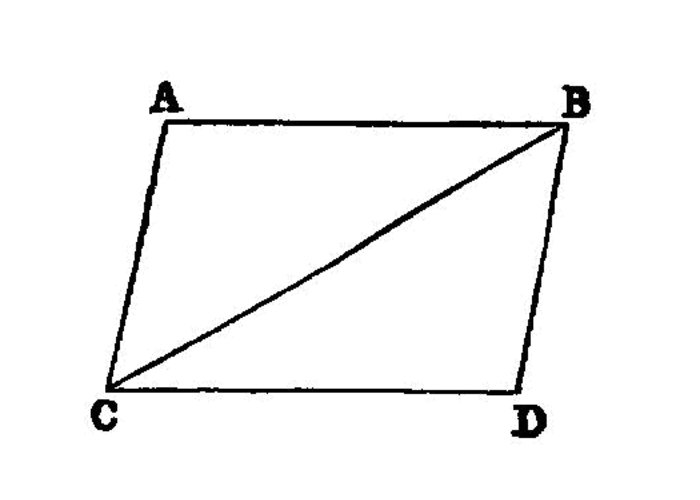Proposition I.33

The straight lines joining equal and parallel straight lines (at the extremities which are) in the same directions (respectively) [^I.33:1] are themselves also equal and parallel.
Let AB, CD be equal and parallel, and let the straight lines AC, BD join them (at the extremities which are) in the same directions (respectively); I say that AC, BD are also equal and parallel.
Let BC be joined.
Then, since AB is parallel to CD, and BC has fallen upon them,
- the alternate angles
ABC,BCDare equal to one another. I.29
And, since AB is equal to CD,
- and
BCis common, the two sidesAB,BCare equal to the two sidesDC,CB; 1 and the angleABCis equal to the angleBCD; therefore the baseACis equal to the baseBD, and the triangleABCis equal to the triangleDCB, and the remaining angles will be equal to the remaining angles respectively, namely those which the equal sides subtend; I.4 therefore the angleACBis equal to the angleCBD.
And, since the straight line BC falling on the two straight lines AC, BD has made the alternate angles equal to one another,
ACis parallel toBD. I.27
And it was also proved equal to it.
Therefore etc.
- Q. E. D.
References
Footnotes
[^I.33:1]. joining...(at the extremities which are) in the same directions (respectively).
I have for clearness' sake inserted the words in brackets though they are not in the original Greek, which has joining...in the same directions
or on the same sides,
tiwards the same parts,
though usage has sanctioned it, is perhaps not quite satisfactory.
-
DC, CB
and 18.DCB. The Greek has
andBC,CD
in these places respectively. Euclid is not always careful to write in corresponding order the letters denoting corresponding points in congruent figures. On the contrary, he evidently prefers the alphabetical order, and seems to disdain to alter it for the sake of beginners or others who might be confused by it. In the case of angles alteration is perhaps unnecessary; but in the case of triangles and pairs of corresponding sides I have ventured to alter the order to that which the mathematician of to-day expects. ↩BCD
